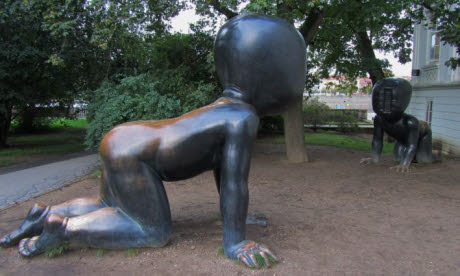
Polly Allen is on a mission to leave the tourists behind and uncover the lesser-known artistic sites on Prague's streets
While the big hitters like Florence and Vienna are considered to be traditional art destinations, Prague is a great alternative, offering a more eclectic range of artists. From pioneering photographers to politically-motivated sculptors, there’s no way you’ll run out of creative types to track down in the galleries and in the streets. Just don’t expect to find many still life paintings of fruit bowls here...
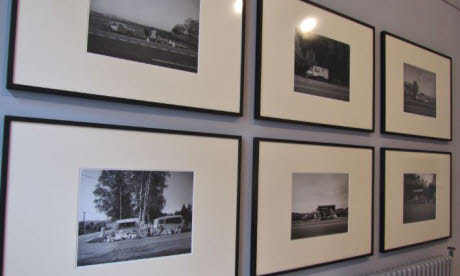 1. Leica Gallery
1. Leica GalleryWhere: Školská 28, 110 00 Praha 1
How much: entrance fee 70CZK
More info: www.lgp.cz/en
Not only does this exhibition space showcase the best of local and international photography, with past exhibitors including Sebastião Salgado, but it’s complemented by a café and bookshop. Here you can pick up camera-shaped cookies and flick through industry journals and magazines. Space is at a premium, but the three rooms of the gallery contain sensitively curated displays, which you can linger over as long as you want. If you choose to hang around on Školská Street after you’ve visited the gallery, it’s worth popping into Café Therapy just down the road, for a quiet and suitably relaxing drink. You might even find some subjects willing to pose for your own photos.
Don’t miss: The current Leica exhibition, focusing on Jan Malý, who made a career out of documenting Czech people’s daily lives. This retrospective, which is Malý’s first exhibition in 33 years, runs until 3rd November 2013.
Where: Dum U Kamenneho zvonu, Staroměstské náměstí 13
How much: entrance fee 120CZK
Once you’ve finished being dazzled by the crowds clustered around the Astronomical Clock, make a beeline for the House at the Stone Bell, a 13th century Gothic building found in the Old Town Square. Inside you’ll find part of the City Gallery of Prague, where modern Czech art mingles with Gothic architecture. Previous exhibitors have included the filmmaker Jan Švankmajer and the photographer Viktor Kolář, who teaches at the Film and TV School of the Academy of the Performing Arts in Prague (FAMU).
The house was built for royalty and has a rich past of its own, including gaudy Baroque renovations, which were thankfully stripped back to reveal the Gothic beauty underneath; you get a real sense of this on the ground floor, where the oldest parts of the building can be seen.
Don’t miss: A peek at the Stone Bell itself, which is on the corner of the building's facade. Although it's a copy rather than the original, it's something of an icon.
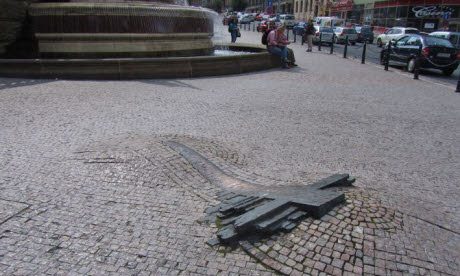 3. Jan Palach Memorial
3. Jan Palach MemorialWhere: Vaclavske Namesti, in front of the National Museum
How much: no charge
More info: www.janpalach.cz/en/default/mista-pameti/nm
One of Prague’s most poignant public art pieces is the memorial to Jan Palach, who set himself on fire as a protest in Wenceslas Square back in 1969. Despite the act itself and Palach’s subsequent death sending shockwaves around the world, the memorial itself isn’t designed to be conspicuous, and its significance is easily missed by tourists traipsing past the National Museum at the top of Wenceslas Square. Do your bit and pay tribute to Palach by looking down at the warped crucifix and cobblestones beneath your feet, facing the spot where he fell, imitated a week later by another like-minded protester, Jan Zajíc. Their lives are commemorated every 16th January across the country.
Don’t miss: The chance to compare artwork. Head to the bottom of Petřín Hill and see the Memorial to the Victims of Communism, sculpted by Olbram Zoubek, which consists of six bronze figures positioned on the steps, seemingly decaying.
Where: Nábřeží Edvarda Beneš, Letna Park
How much: no charge
Views of Letna Park from the Old Town and Josefov are interrupted by the movement of a bright red metronome swinging back and forth. This kinetic sculpture was designed by local artist Vratislav Karel Novák and was unveiled at the Universal Exhibition in 1991. The metronome’s location is key to its meaning – this is the place where the world’s largest statue of Lenin briefly stood from 1955-1962, watching over the city's residents.
In the period between Lenin’s removal and the arrival of the metronome, local artist David Černý placed an installation art here in 1991, representing Stalin's tomb. The installation was featured in a recent Prague-set novel by American writer Caleb Crain, called Necessary Errors.
Don’t miss: A photo opportunity from the Metronome, looking across to the bridges spanning the Vltava, with the Old Town in the background.
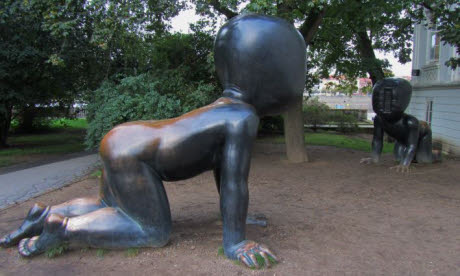 5. David Černý
5. David ČernýWhere: various locations including Kampa Park and the German Embassy
How much: no charge
Everyone in Prague has an opinion on David Černý, the man responsible for the city’s most outspoken and controversial artworks, often dripping with sarcasm. He rose to fame in 1991 after painting a Soviet tank pink, an act that saw him arrested for ‘hooliganism’ but didn’t deter him from pushing creative boundaries. While you can pay to see some of his more challenging works, such as the headline-grabbing Brownnosers installation in the Futura Gallery, there are many others to see for free.
Kampa Park is home to three bronze babies, and the nearby Kafka Museum has the not-so-child-friendly Piss sculpture. The garden of the German Embassy hosts Quo Vadis?, a Communist-era Trabant car with legs.
Don’t miss: The Žižkov Tower, where Černý has strategically placed more babies – this time in fibreglass – crawling to the top. The artwork was only meant to be temporary; public opinion has seen it remain firmly in place.
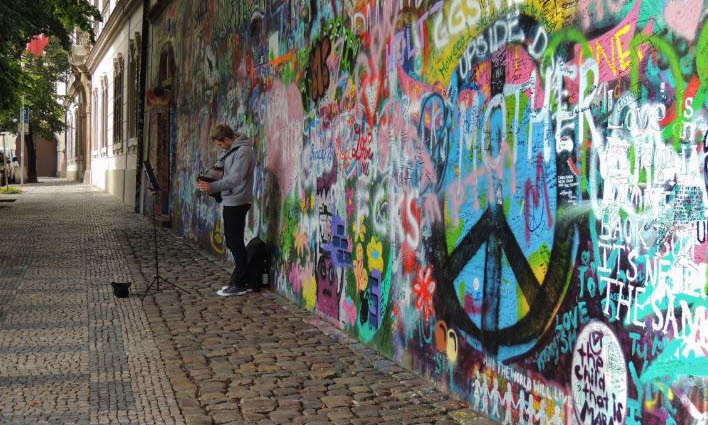 6. The John Lennon Wall
6. The John Lennon WallWhere: Velkopřevorské náměstí
How much: no charge
An integral part of many of the city’s walking tours, the graffiti-strewn John Lennon Wall is a continual photo opportunity for visitors. The graffiti first appeared after Lennon’s death in 1980, when anonymous locals sprayed their feelings of solidarity with the music legend and his peaceful protests – something that was especially important considering the lack of freedom of speech under Soviet control. Initially the wall’s owners (the mysterious Knights of Malta) removed the graffiti but, as it began to prove popular, they left it untouched. While you can’t see many of the original layers, there’s still much to enjoy here. Plus, if you’re lucky enough to catch an opportunistic busker playing Beatles songs beside the graffiti, you’ll have the full atmospheric treatment.
Don’t miss: A peek at the nearby John Lennon pub. It might sound like a commercial sell-out, but the interior of this pub proves that it’s run by serious Beatles fans, with a seemingly endless stream of memorabilia on the walls (and a life-size British phone box by the bar).
Where: Panská 890/7
How much: entrance fee 120-180CZK
More info: www.mucha.cz
While Černý may be the bad boy of the city, Mucha (pronounced Moo-ka) is definitely the golden child, but his work is often overlooked by tourists in favour of flashier sights and more impressive-looking museums. The Mucha Museum, tucked away on a side street between Na Prikope and Wenceslas Square, acts like a blank canvas for his larger-than-life prints and posters. Mucha honed his radical Art Nouveau style in Paris and secured a six-year contract promoting actress Sarah Bernhardt; he later moved to America before returning to Prague and creating an incredibly patriotic series of huge paintings called the Slav Epic.
Don’t miss: Glimpses of Mucha's Parisian sketchbooks and some early prototypes of his posters for various clients, including his first for Bernhardt, advertising her performance of Gismonda.
Where: Dušní, beside the Spanish Synagogue
How much: no charge
Perched on the edge of the Josefov quarter is this suitably bizarre and cerebral statue of Franz Kafka, depicted sitting on a headless man’s shoulders (the identity of the headless man is up for debate; local guides will tell you this is Kafka’s father). Track down the statue in Dušní Street, where the author used to live, and pay your own tribute. The sculptor, Jaroslav Rona, was inspired by one of Kafka’s short stories, Description of a Struggle. Rona, himself a bit of a maverick, has previously exhibited at the House at the Stone Bell and is also an art teacher and an actor.
Don’t miss: The chance to explore Josefov further. It’s home to the multi-site Jewish Museum of Prague, which you can explore with a combined entry ticket. The Pinkas Synagogue and the Old Jewish Cemetery should definitely be on your agenda.